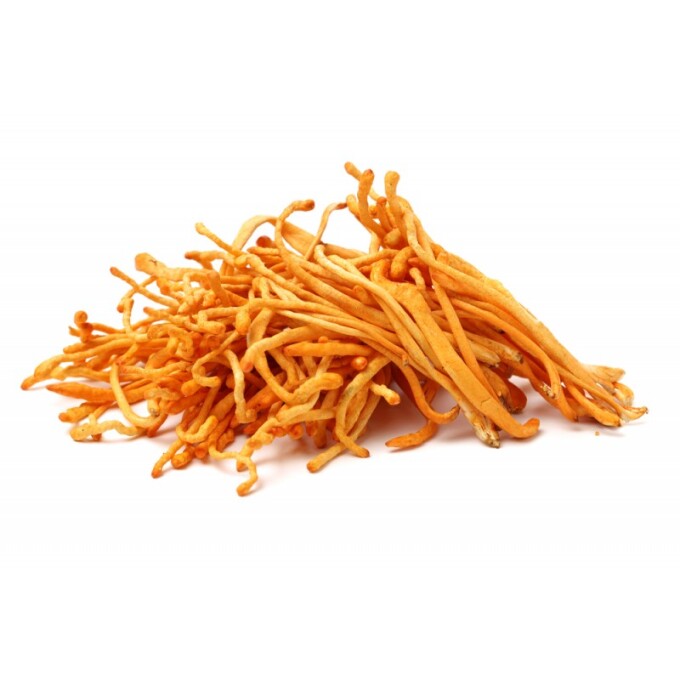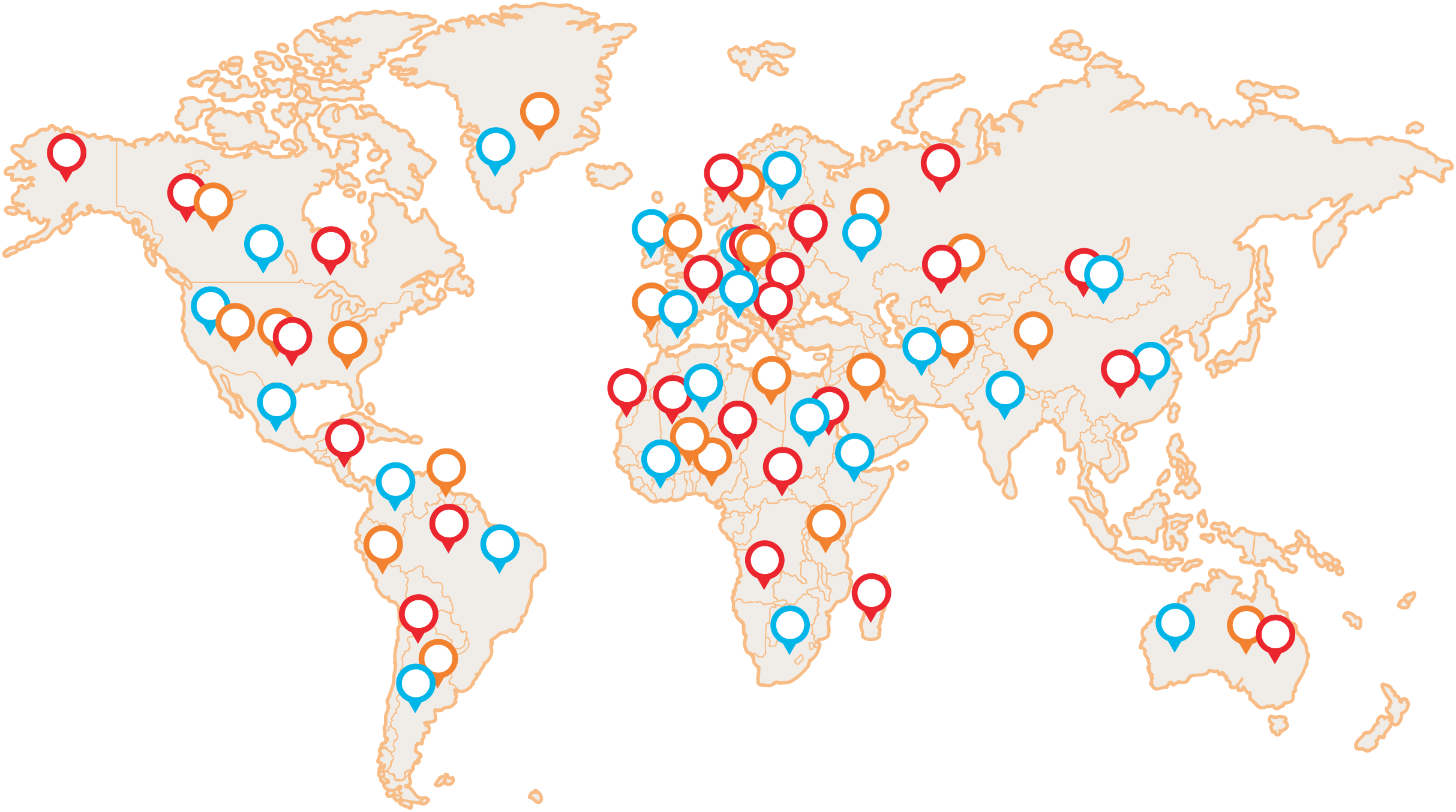Cordyceps militaris (Red Caterpillar, Scarlet Caterpillarclub, Dong Chong Xia Cao) belongs to the heath-rush mushrooms. It is found, unlike its relative Cordyceps sinensis, all over the world. It inhabits North America, Europe, Asia... It prefers the northern hemisphere. It is mainly found in mixed and deciduous forests. Although it has a yellow to orange club-shaped fruit, it is often difficult to find. It is embedded in grasses, leaves and needles, which hide it. The fruiting body measures about 2-7 cm, is slightly flattened, and the spore area is slightly expanded. The spine is slightly lighter in colour than the head and remains hidden in the soil, in the shell of the infested insect. Its life, and therefore its occurrence, is strongly dependent on the presence of the insect it infects. Cordyceps militaris infects the larvae and pupae of moths and butterflies, but less so on beetles, white-winged or two-winged. Spores of C. militaris attach to insect larvae/pupae that burrow into the ground for the winter. The spores literally bore through the hard shell of the insect and enter the interior, where a mycelium begins to form that uses nutrients from the infected insect and completely fills the host's shell. They then emerge from the shell in the summer, growing directly from the rest of the larva/pupa.
Due to its abundance and ease of cultivation, it is often used in place of C. sinensis, whose occurrence is restricted to one type of insect and the high altitudes of the Himalayas.
C. militaris was described by C. von Linné in 1753, at which time it was given the name Clavaria militaris, and in 1833 it was renamed Cordyceps militaris by the German mycologist J. H. F. Link, a name it has retained. Nowadays, other synonyms are also used to refer to C. militaris, e.g. Clavaria militaris, Sphaeria militaris, Torrubia militaris are still used.
Cordyceps militaris is also known in our country. In a text from 1955, Kubička reported on the occurrence of the red caterpillar in the Třeboň region. The fungus was also found in 1988 in the Jihlava region.
Cordyceps is highly sought after, as it has similar benefits and composition to C. sinensis, which is very rare and difficult to cultivate artificially.C. militaris can be cultivated. Its use and cultivation probably has the longest tradition in China, where traditional Chinese medicine works with it. There are also two approved standardized products in China, C. militaris mycelial powder (Z20030034) and capsules (Z20030035), which are produced by Jilin Zhongsheng Pharmaceutical Co ,There are also many food supplements in China that contain C. militaris. It is reported that about 3 billion C. militaris products are sold annually.
C. militaris can therefore be cultivated on a large scale. However, the most commonly used insects are the silkworm and the Chinese martin. In some nurseries, C. militaris is also grown on cabbage moth, mealy bug or corn earworm. As it happens that the necessary insects cannot be found or the substrate is infected and contaminated with them, substrates on which C. militaris can be grown are also sought. C. militaris thrives, for example, on rice or soybean substrates. The mycelia do not grow enclosed in a chitin shell but on the surface of the prepared medium and absorb nutrients from the substrate. The individual hyphae go deeper and from there they extract the necessary substances.
During cultivation it is necessary to maintain the correct humidity and temperature, as well as the nutrient levels. Although it is possible to grow C. militaris, unlike C. sinensis, it is not entirely easy.
Composition of C. militaris:
Like other vital mushrooms,C. militaris harbours a large number of bioactive compounds that exhibit pharmacological effects.
Carbohydrates, polysaccharides, monosaccharides:
The most important components of mushrooms are undoubtedly carbohydrates, especially polysaccharides. C. militaris is rich in both beta and alpha glucans, which are both 1→3and 1→6branched. The polysaccharide cordlan is typical for C. militaris. Another polysaccharide extracted from C. militaris is also CPS-1, which is composed of 5 types of monosaccharides, mannose, xylose, rhamnose, galactose and glucose. Of course, the list of polysaccharides is far from ending, as there are a large number of glucogalactomannans in the mushroom.
In addition to polysaccharides, C. militaris also contains monosaccharides, which are single-component sugars, such as glucose, galactose, mannose, xylitol and mannitol. The latter is also known as cordycepinic acid. D-mannitol is also used medicinally as a diuretic, i.e. it increases fluid excretion, thus reducing swelling. It is also a sweetener suitable for diabetics, etc.
If we talk about carbohydrates, it is also impossible not to mention water-insoluble polysaccharides, which are referred to as coarse fibre, which is non-absorbable and is a source of nutrients for our intestinal microflora. Its correct composition significantly enhances our health, and vice versa. Changes in its composition can cause immune system disorders, inflammatory diseases, psychological disorders, obesity, etc.
Amino acids and proteins in C. militaris:
Amino acids and proteins are another important component of C. militaris. Amino acids are actually the building blocks of proteins. We divide them into two main groups according to whether our body can make them - non-essential, or cannot make them - essential, which we must take in with food. In C. militaris are also essential amino acids. The total amount of amino acids is about 70 mg/g dry matter in the amniotic fluid. The highest concentration of amino acids in C. militaris is lysine, followed by glutamic acid, proline, threonine, alanine, arginine, etc. In addition, aspartic acid, tyrosine and valine are present in the mycelia.
Important proteins in the fungus include enzymes that help the fungus to break down substances and obtain nutrients, but also to synthesize or protect the fungus. C. militaris contains enzymes that have been shown to have fibrinolytic activity, i.e. they can dissolve blood plugs, thrombi. Other representatives are superoxide dismutase, which neutralizes free radicals, trypsin protease, cellulases...
C. militaris is characterized by the presence of a peptide called cordymin, it is a peptide with many biological effects, in the case of cultivation with fungi and yeasts (Aspergillus fumigatus, Fusarioum oxysporum, Candida albicans) it has been able to limit their growth. Cordymine also acts as a blocker of HIV-1 reverse transcriptase, etc.
Protein compounds in C. militaris include lectins, cordyheptapeptide, C. militaris protein (CMP), etc.
In this section, we will also mention the polysaccharide-peptide complexes designated as CPSP-F1,-F2 and-F3, which inhibit acetylcholinesterase activity. This is the enzyme that breaks down acetylcholine, which is an important neurotransmitter. So if it's not broken down, there's more of it, and that can improve cognitive function, for example in Alzheimer's disease.
Fatty acids in C. militaris:
Mushrooms in general are minimally caloric and non-fatty, yet they also carry fatty acids. Thus, they do not contain cholesterol, but also polyunsaturated fatty acids, which have a positive effect on our organism. These include linolenic, linoleic and oleic acid. The unsaturated fatty acids are palmitic and stearic acid. Polyunsaturated fatty acids account for approximately 69 % of all fatty acids.C. militaris therefore has a very suitable fatty acid composition.
Nucleosides in C. militaris
Nucleosides are compounds of nucleic bases and sugars and are part of the genetic information, i.e. DNA and RNA. A wide range of nucleosides are found in C. militaris. These include uridine, adenosine, guanosine, homocitrullylaminoadenosine, etc.
The most important are adenosine and cordycepin (3'-deoxyadenosine) and e.g. 5'-(3'-deoxy-β-D-ribofuranosyl)-3'-deoxyadenosine. Adenosines are also used in medicine to affect heart rhythm, namely to slow tachycardia. Cordycepin is a very distinctive compound that gives Cordyceps many of its effects. Adenosine makes up 0.18% of the dry weight of the fruit, cordycepin 0.97%. However, their concentration in the mushroom can be increased by changing the substrate on which the mushroom is grown.
Minerals in C. militaris:
Cordyceps militaris is also a carrier of mineral and trace elements. Their concentration depends very much on whether they are present in the substrate on which the mushroom grows, so whether it can 'pull them in'. Calcium, silicon, magnesium, sodium, phosphorus, sulphur, zinc, selenium, etc. are the most abundant in C. militaris.
Vitamins in C. militaris:
Not only minerals can be found in C. militaris, there are also vitamins in it. Their quantity and types are also determined by the substrate, the place where the mushroom grows. For example, B vitamins have been extracted, including vitamin B12, which is found in the fungal mycelia, as well as vitamin E and D and carotenoids. Among the carotenoids in C. militaris include cordyxanthin-I ( (2,3,2′,3′-tetradehydro-18,16′,17′,18′-tetranor-ε, ε-carotene-5, 5′, 1′ -triol), cordyxanthins-II (2,3,2′,3′-tetradehydro-18, 1′,16′,17′, 18′-pentanor-ε, ε-carotene-5, 5′, -diol), cordyxanthins-III (2,3,2′, 3′-tetradehydro-18,17′,18′-trinor-ε, ε-carotene-5, 5′, -diol) and cordyxanthins-IV (2,3,2′,3′-tetradehydro-18,18′-dinor-ε, ε-carotene-5,5′, -diol).
Phenolic compounds, organic acid flavone compounds, etc.
Phenolics and compounds derived from them are not lacking in C. militaris. These substances have confirmed antioxidant effects. Phenols such as quercetin, p. hydroxybenzoic acid, fumaric acid and cinnamic acid are not lacking in C. militaris. Of the organic acids, oxalic and citric acids are also present. The phenolic compounds contained in C. militaris have significant antioxidant effects. For example,quercetin, cinnamic acid and p-hydroxybenzoic acid can be found in C. militaris . Flavone compounds are represented by genistein, dainzein and glycitein.
http://doi.org/10.1080/21501203.2015.1043967
https://doi.org/10.1016/j.carbpol.2013.04.049
https://doi.org/10.1263/jbb.100.631
https://doi.org/10.1016/j.ijbiomac.2016.09.048
https://doi.org/10.1016/j.bbagen.2007.01.005
https://doi.org/10.1016/j.jfda.2016.10.013
https://doi.org/10.1016/j.jff.2013.06.002
http://doi.org/10.1142/S0192415X07005120
museum.ji.cz/vsv_prirodni/Svazek-IX-1989/12_Vampola-3.pdf
 Vital mushrooms PRO (16)
Vital mushrooms PRO (16) MyTao Edition (14)
MyTao Edition (14) Vital Mushroom Extracts (25)
Vital Mushroom Extracts (25) Combination of mushrooms and herbs (19)
Combination of mushrooms and herbs (19) Traditional recipes (5)
Traditional recipes (5) BIO vital mushrooms powder (9)
BIO vital mushrooms powder (9) Syrups (12)
Syrups (12) Dried vital mushrooms (6)
Dried vital mushrooms (6) Honey products (5)
Honey products (5) Vitamins (4)
Vitamins (4) BIO green food (2)
BIO green food (2) Other (2)
Other (2)

